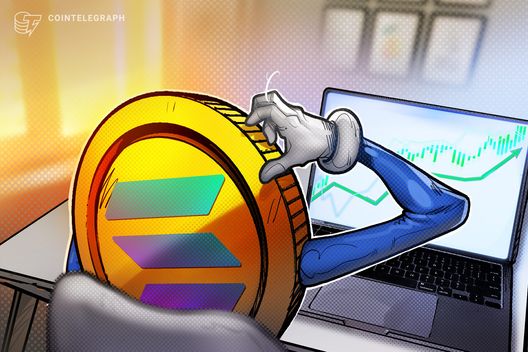
Das Fintech-Unternehmen Revolut setzt vermehrt auf Krypto-Zahlungen. So soll das Lightning-Netzwerk nach Europa und wohl auch Deutschland kommen.

Finanzmittel Info + Krypto + Geld + Gold
Krypto minen, NFT minten, Gold schürfen und Geld drucken

Das Fintech-Unternehmen Revolut setzt vermehrt auf Krypto-Zahlungen. So soll das Lightning-Netzwerk nach Europa und wohl auch Deutschland kommen.

Solana steigt am 8. Mai auf 150 US-Dollar. In den vergangenen Tagen gab es hier institutionelle Käufe von zwei Unternehmen.
What recently appeared as a rare opportunity for bipartisan agreement on cryptocurrency regulation has hit a significant roadblock, directly attributable to President Donald Trump’s expanding personal and business entanglements within the digital asset space.
Congressional Democrats, citing concerns over potential conflicts of interest and personal enrichment, are now expressing strong reservations about advancing landmark stablecoin legislation, jeopardizing its path forward.
The legislation in question, the Guiding and Establishing National Innovation for US Stablecoins of 2025 (GENIUS Act), successfully cleared the Senate Banking Committee in March with support from both parties, signaling a potential quick win for the crypto industry seeking regulatory clarity.
However, momentum has stalled as scrutiny intensifies over President Trump’s various crypto endeavors.
These activities include the pre-inauguration launch of his own $TRUMP meme coin, reported involvement with a new stablecoin (USD1) via the Trump family-backed World Liberty Financial, suggestions of a potential family stake in the major exchange Binance (linked to an Abu Dhabi investment deal using USD1), and a partnership between the Trump Media & Technology Group and Crypto.com.
Furthermore, an upcoming dinner exclusively for top holders of his meme coin has drawn criticism, reportedly even raising eyebrows among crypto-supportive Republicans like Senator Cynthia Lummis.
This backdrop prompted nine Senate Democrats, including notable figures who previously voted for the bill in committee, to issue a statement over the weekend declaring they would not support the GENIUS Act in its current form.
While their official statement highlighted necessary improvements – citing the need for “stronger provisions on anti-money laundering, foreign issuers, national security, preserving the safety and soundness of our financial system, and accountability” – other prominent Democrats linked their opposition more directly to the President’s actions.
“Since the committee vote, president Trump’s aggressive efforts to profit from stablecoins and the obvious opportunities for bribery and other influence peddling have demonstrated why it is vital that we make meaningful, substantive reforms to the bill,” stated Senator Elizabeth Warren, a leading voice on the Banking Committee, in a Monday speech.
The resistance reflects a growing unease among Democrats about potentially legitimizing or facilitating activities they perceive as problematic.
The concern isn’t necessarily directed at stablecoin regulation itself – the senators’ statement acknowledged that “the absence of regulation leaves consumers unprotected.”
Rather, the opposition targets the current legislative vehicle in the specific context of the President’s apparent conflicts.
Democrats appear unwilling to lower regulatory guardrails or advance crypto legislation that could be seen as enabling potential corruption at the highest level.
Further underscoring this sentiment, Democratic Senator Jeff Merkley introduced the “End Crypto Corruption Act” on Tuesday.
This proposed legislation aims specifically to prohibit the president and other high-ranking federal officials from issuing, sponsoring, or endorsing digital assets.
“Currently, people who wish to cultivate influence with the president can enrich him personally by buying cryptocurrency he owns or controls,” Merkley asserted in a statement accompanying the bill’s introduction.
The impasse over the stablecoin bill casts a shadow over prospects for more comprehensive crypto market structure legislation, something the industry has sought for years.
The political friction generated by the President’s crypto ties makes navigating any crypto-related bill more challenging.
Representative Maxine Waters, the leading Democrat on the House Financial Services Committee, also signaled resistance this week, objecting to a joint hearing intended to address these broader market structure issues.
Financial policy analyst Jaret Seiberg of TD Cowen viewed the situation primarily through a political lens, noting that Trump’s personal stake complicates Democratic support for a bill potentially regulating his family’s business interests.
However, he still predicted the stablecoin bill could eventually pass, potentially after Democrats extract significant concessions, given the crypto lobby’s considerable political influence and resources.
Industry lobbyists, meanwhile, appear concerned by the stalling momentum, issuing statements urging lawmakers to move the GENIUS Act forward to provide necessary regulatory clarity, support stablecoin adoption, and maintain US leadership in the digital economy.
The immediate future of the stablecoin bill, however, now appears hostage to the political fallout from the President’s controversial foray into the crypto world.
The post Crypto news today: stablecoin bill hits political wall as democrats question Trump’s crypto ventures appeared first on CoinJournal.

Bitcoin wird auf den Börsen immer knapper. Der Bestand erreicht hier ein 2-Jahres-Tief. Explodiert der Kurs jetzt über 100.000 US-Dollar?
Stellar (XLM) is navigating a complex landscape in 2025.
While the blockchain network continues to gain traction as a real-world asset (RWA) hub, concerns around centralisation and potential market manipulation are also intensifying.
Stellar has recorded an 84% rise in RWA-linked value this year, surpassing $500 million.
However, with nearly 80% of XLM supply controlled by just ten wallets, analysts warn of volatility risks if large holders move to sell.
Meanwhile, daily wallet growth and rising exchange balances suggest expanding adoption but also potential sell pressure.
As institutional products integrate with Stellar and retail participation climbs, investors remain split on whether the current distribution model can support long-term price stability without triggering major corrections.
The top 10 wallets hold around 25 billion XLM out of a total of 30.9 billion in circulation, equating to roughly 80% of the available token supply.

Source: CoinMarketCap
This significant imbalance raises questions about decentralisation and network resilience.
In contrast, 90% of holders reportedly own fewer than 100 XLM, giving them little influence over market trends.
Such concentration could have serious implications for XLM’s price stability.
If a small number of holders were to liquidate significant volumes, the market could face sharp corrections.
The risk is further amplified by rising exchange balances, with XLM held on Binance growing from 180 million in late 2023 to 1 billion by May 2025, according to stellar expert.
This increase points to higher trading interest, but also the possibility of mounting sell pressure.
Despite supply concerns, Stellar has made clear inroads into the tokenisation of real-world assets — a sector drawing institutional capital and crypto-native investment in 2025.
Stellar currently ranks as the third-largest protocol by RWA market capitalisation, trailing only Ethereum and ZKsync Era.
Institutional-grade products like the Franklin Templeton OnChain US Government Money Fund, valued at $497 million, and Circle’s USDC stablecoin with $345 million on the Stellar chain, have helped push the total RWA value on Stellar to over $500 million.
This is up from $275 million in January, marking an 84% increase within five months.
Such growth signals that more traditional financial institutions are considering Stellar as an alternative to Ethereum for tokenized assets.
Faster transactions and lower costs remain key attractions.
The XLM network has also shown strong user base expansion. Stellar’s active accounts grew from 7.2 million in 2023 to 9.5 million by May 2025.
This represents an average addition of about 5,000 wallet addresses daily. The growth helps counterbalance the impact of concentrated holdings, as demand rises across a broadening user base.
This daily activity reflects more than speculative trading.
It suggests growing confidence in Stellar’s long-term utility, particularly in the RWA sector.
While increased circulating supply often raises concerns about dilution or dumping, in Stellar’s case, it appears aligned with deliberate expansion strategies aimed at onboarding more institutional and retail users.
While Stellar’s RWA integrations and active user growth highlight ongoing demand, the risk associated with token concentration cannot be overlooked.
If the top holders — or “whales” — choose to exit positions, price shocks are likely.
However, if network development continues alongside strategic RWA partnerships, the Stellar blockchain could retain and grow its niche within the broader crypto asset ecosystem.
Although Stellar’s fundamentals appear strong, investors are likely to remain cautious until the network addresses its centralisation risks.
Efforts to increase token distribution, improve governance, or introduce staking mechanisms may help mitigate future volatility.
The post Stellar gains ground in RWA market, but 80% XLM supply held by few stirs concern appeared first on CoinJournal.